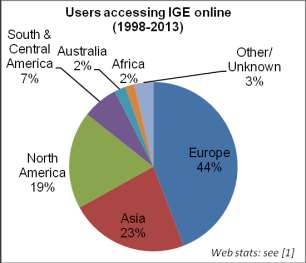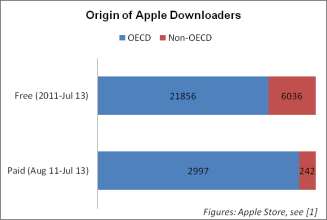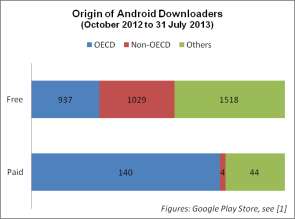Creating educational and commercial access to English language resources: using corpora for English language teaching and learning
Submitting Institution
University College LondonUnit of Assessment
English Language and LiteratureSummary Impact Type
CulturalResearch Subject Area(s)
Psychology and Cognitive Sciences: Cognitive Sciences
Language, Communication and Culture: Linguistics
Summary of the impact
We used the research consolidated in the British Component of the
International Corpus of English
(ICE-GB) to build the Internet Grammar of English (IGE), a
web-based introductory English
grammar; and an app for smartphones and tablets, called the interactive
Grammar of English
(iGE). The app is based on the IGE website, but was fully updated with new
materials and
exercises. Both resources have had educational and commercial impact as
tools for English
language teaching, reaching over 1.2 million users in 2008-2013 through
the website and over
34,500 through the app.
Underpinning research
UCL's Survey of English Usage (SEU) research centre carries out research
in English Corpus
Linguistics, specifically English grammar: instituted in 1959, it was the
first centre in Europe to
undertake this type of research. Between 1990 and 1997, the SEU created
the British Component
of the International Corpus of English (ICE-GB) (www.ucl.ac.uk/english-usage/projects/ice-gb)
[a].
The grammatically analysed collection of language samples on ICE-GB
contains a combined total
of around 1 million words of written and spoken English, some 600,000 of
which are fully parsed
(grammatically analysed) examples of spoken English. As one of the largest
collections currently
available anywhere in the world, the corpus has been, and continues to be,
an indispensable data-mining
resource for anyone interested in the grammar and linguistic
features of both the spoken
and written word. Complex and detailed searches of the corpus can be
conducted using its
innovative and world-leading exploration software ICECUP (International
Corpus of English Corpus
Utility Program): designed and developed at the SEU, ICECUP was originally
released in 1998;
version 2 was released in 2006. Using ICECUP, instances of grammatical and
lexical constructions
can be extracted from the corpus in intelligent ways, and to ascertain
linguistic trends including
contextual and frequency data for a vast array of linguistic features in
actual use. In 2002, SEU
researchers published a comprehensive reference to ICE-GB, including the
use of ICECUP [b].
The research was funded by a number of grants (ESRC, Leverhulme Trust,
and British Sasakawa
Foundation), whose Principal Investigators were Professor Sidney
Greenbaum, Dr Mark Huckvale
and Sean Wallis, all of UCL during the research period.
In 1998 the Survey of English Usage used the grammatical annotation of
spoken and written
English in ICE-GB to develop the IGE website. The website's enduring
popularity led, in 2011, to
the provision of funding from UCL Business PLC for the development of the
iGE smartphone/
tablet app. This was launched for Apple devices in 2011, an Android
version following in 2012. The
IGE website was developed in a project funded by the Joint Information
Systems Committee (JISC;
grant reference JTAP 2/247), whose Principal Investigators were Professor
Bas Aarts and Dr
Douglas Arnold (University of Essex), with research conducted primarily at
the SEU. Alongside
Professor Aarts, UCL researchers working on this project included Dr
Gerald Nelson (Deputy
Director of the SEU, 2004-2007, currently Professor of English Linguistics
at Chinese University of
Hong Kong), and Justin Buckley (researcher in the SEU, 1995-1998).
The development of the ICE-GB and, subsequently, of the IGE website was
both supported by and
itself fed into broader research undertaken within UCL's Department of
English. This has included
the production of numerous reference grammars based on Survey of English
Usage corpora, both
the ICE-GB corpus and others. Such grammars include Sidney Greenbaum's Oxford
English
Grammar (1996, based on ICE-GB), and Bas Aarts's Oxford Modern
English Grammar (2011; also
based on ICE-GB) [c].
References to the research
[a] The British Component of the International Corpus of English
(ICE-GB). CD-ROM., London:
Survey of English Usage, University College London. First release: 1998;
second release: 2006.
Available on request.
[b] Nelson, Gerald, Wallis, Sean and Aarts, Bas. Exploring natural
language: the British component
of the International Corpus of English. 2002. Varieties of English
Around the World series.
Amsterdam: John Benjamins. Available on request.
[c] Aarts, Bas. Oxford modern English grammar. 2011. Oxford:
Oxford University Press. Submitted
to REF2.
Key grants underpinning the research included
ESRC Grant RES-000-23-1286. Awardees: Professor Bas Aarts and Sean
Wallis. Next generation
tools for linguistic research in grammatical treebanks. Period: 1
January 2006 - 31 December
2007. Value: £155,832.83.
ESRC Grant R000222598. Principal Investigator: Mr Sean Wallis, SEU. Development
of an
effective grammatical query methodology in the context of a parsed
corpus. 1 March 1998 - 31
January 1999. Value: £37,962.
EPSRC Grant GR/K75033. Principal Investigator: Dr Mark Huckvale. The
development of an
automatic parsing system using the ICE Corpus as linguistic knowledge
base. Period: 1 September
1995 - 30 September 1997. Value: £187,264. This project was graded as a
`very significant
contribution to the field' with `good use of resources'.
Joint Information Systems Committee (JISC) Grant JTAP 2/247. The
Internet Grammar of English.
Principal Investigator: Professor Bas Aarts and Dr Douglas Arnold. Period:
1 August 1996 - 1
August 1998. Value: £125,689
Details of the impact
The use of UCL research to develop ICE-GB and later the IGE website has
provided an innovative,
free resource for English grammar teaching and learning which has
profoundly enhanced
educational opportunities and standards both within and beyond formal
education systems, all
around the world. Since its inception in 1998, the IGE website has
attracted 3.7m users worldwide;
between 2008 and 2013 it reached more than 1.2m users, including a core of
over 215,000 repeat
users.
Provision of an educational resource for individual learners around
the world
There is a long tradition of using artificial,
invented examples to illustrate grammatical
phenomena to learners (e.g. The cat sat on the
mat.). However, teachers and learners find the
artificiality of these examples a barrier to their
ability to get to grips with how grammar applies
to real life. The IGE website and iGE app
remedy this problem by making use of
authentic examples sourced from the ICE-GB
corpus to help learners acquire real English.
The IGE website is freely available and has
received over 1.3m hits since 2008 (over 3.7m
hits since inception in 1998). These range from
184,046 to 337,561 per year. Visits from
unique users range from 149,642 to 298,089
per year while 30-50,000 per year are repeat
users, totalling over 215,000 repeat users since 2008. Although overall
page hits declined from
2008 to 2011, they were on the rise again through 2012 and the first half
of 2013 [1]. The website
brings key insights from UCL's long history of research into English
grammar use to global users,
as shown by the chart below, which demonstrates its appeal in the world's
biggest markets for
English learning.

As a direct extension and further development of the IGE website, the iGE
app sustains and
expands IGE's impacts on beneficiaries in the non-academic educational
sector and in the
commercial sector by expanding its reach from the web to an easily
accessible offline app. The
iGE app is available in both free and paid versions. It has been
downloaded by over 34,500 users
who can now access innovative grammar lessons and exercises any time,
anywhere. The paid
version has been downloaded by around 3,500 users (Apple version £4.99,
Android version £2.99)
and the free version by over 31,000 users [1]. The app helps maintain
IGE's global reach and user-base:
while the paid versions of the app are largely accessed in OECD
countries such as the UK,
US, and Australia, the free versions allow access to the vast number of
people in non-OECD
countries who are interested in learning English. Thus, the free version
of the Apple app has a
significantly higher proportion of downloaders from non-OECD countries,
and while downloaders of
the paid version are based in only 33 different non-OECD countries, those
for the free version
come from 74 [1].

 Note: The Google Store only gives the top ten countries from which apps have been downloaded.
Thus ‘Others’ may include both OECD and non-OECD countries.
Note: The Google Store only gives the top ten countries from which apps have been downloaded.
Thus ‘Others’ may include both OECD and non-OECD countries.
Note: The Google Store only gives the top ten countries from which
apps have been downloaded.
Thus `Others' may include both OECD and non-OECD countries.
In July 2013, the iGE app had a rating of 5 stars (the highest possible
rating) on both the Apple
App and the Google Play stores. Reviewers described it as: `Authoritative
(as you would expect
from UCL), comprehensive, clear and informative...' [2], and noted
appreciation for the wide range
of materials it included: `Even in the free version', one reviewer wrote,
`there is both scholarly yet
easy to understand content about key aspects of English grammar, as well
as very useful
exercises...The full glossary included is easy to use and a fantastic
reference for students of all
levels. It is clear that this is the product of university-level work,
made accessible to all kinds of
users.' The app has also been positively reviewed elsewhere, including:
Linguistics Research
Digest; iPad English (`an essential purchase for iPad-owning
English teachers... more advanced
EFL/ESL students should also find it useful`) [4]; David Crystal's blog
(`The model presented is a
well-established and influential one, and there are lots of real examples
of usage') [5]; Emphasis
Business Writing Trainers; and the English Editing blog,
which described it as `an essential
acquisition for iPad-owning English teachers and more advanced learners'
and listed iGE in its top
10 apps for learners of English [6]. The most recent review on Google Play
remarks: `This is a
great way to refresh grammatical knowledge for adults....The best part is
the large number of
practice exercises that give great feedback and teach through the errors.
... Worth 10x the cost.
Thank you for making such a quality learning tool' [3].
Provision of a new resource supporting English language teaching
Both the website and the app support individual study, and have provided
an important and freely
available resource for English language teachers the worldwide. Both are
recommended on the
BBC's `Learning English' site, while the IGE website has been recommended
for use by English
language teachers by, among others: the British Council, Macmillan
Dictionaries Online, Guardian
Education Online, Palgrave Study Skills, English Teaching in the UK,
Intute, BUBL English
Language Education, and UsingEnglish.com. Accordingly, it was noted in the
Guardian in 2011
that: `[T]his excellent site offers a detailed and clear course in English
grammar for
undergraduates' [7].
The iGE app has also provided a useful learning resource to accompany
professional educational
courses both within and beyond the UK. For example, it now comprises a
central part of the
curriculum for undergraduate modules in English grammar at University of
York [8] and at Montclair
State University (USA). At MSU, the app is the only required resource for
students enrolled in
`Structure of American English', which in turn is a required course for
all undergraduates in
Linguistics, including those working towards certification in English as a
Second Language [9].
English Language Teaching is a huge growing industry worldwide, described
in 2006 as second
only to North Sea oil in its importance to the British economy [10]. The
SEU has contributed to the
global market in English teaching through its sale of licences of the IGE
website. Since January
2008, 13 such licenses for offline access to the IGE website were
purchased by a number of
companies and individuals [10].
Sources to corroborate the impact
[1] Number of IGE website users: http://bit.ly/171NkMK
[Motigo webstats; note that geolocation
figures cannot be disaggregated by date, so are for 1998-2013]. Google
Play and Apple Store
reports available on request.
[2] iTunes App Store, User Comments, accessed July 2013 (available on
request).
[3] Google Play Store, User Comments, accessed July 2013 (available on
request).
[4] `iPad English' (April 2012): http://bit.ly/15595L7
[ipadenglish.net].
[5] David Crystal (September 2011): http://bit.ly/1d2lwfC
[davidcystal.blogspot.co.uk].
[6] The English Editing Blog (June 2012): http://bit.ly/14xPb7Z
[blog.englishtrackers.com].
[7] Educational resources recommending the IGE website include The
Guardian (2011)
http://bit.ly/18HujPd
[education.guardian.co.uk].
[8] University of York recommended the IGE webpage (and iGE app) for its
Structure of English
module: http://bit.ly/19Gpfz6
[york.ac.uk].
[9] An MSU student writes: `The design of the App allows for an ease of
use... [and] acts as a
mobile textbook that students have found themselves perusing and
interacting with at various
times during the course of the day whether in class or not. Students have
mentioned challenging
themselves with the exercises while in between classes, waiting on lines
for various reasons, and
any time they may have usually found themselves aimlessly wandering the
net. ...Aarts and Wallis
have constructed a useful and exciting App worthy of further classroom
attention.'
For MSU student reviews of the app as a learning resource, see: http://bit.ly/14xRjg3
[ucl.ac.uk]
MSU requirements for Linguistics with Teacher Certification 2012: http://bit.ly/18HvldK
[montclair.edu]; and for 2011: http://bit.ly/16GJk63
[montclair.edu].
[10] Phillipson, Robert. `Language Spread : Sprachverbreitung'. Sociolinguistics:
An international
Handbook of the Science of Language and Society. ed. U. Ammon, N. Dittmar,
K. J. Mattheier and
P. Trudgill. Vol. 3 2.ed. Berlin: Walter de Gruyter GmbH & Co., 2006.
See page 2303 (available on
request). Licenses sold: corroborated by Administrator, Survey of English
Usage.